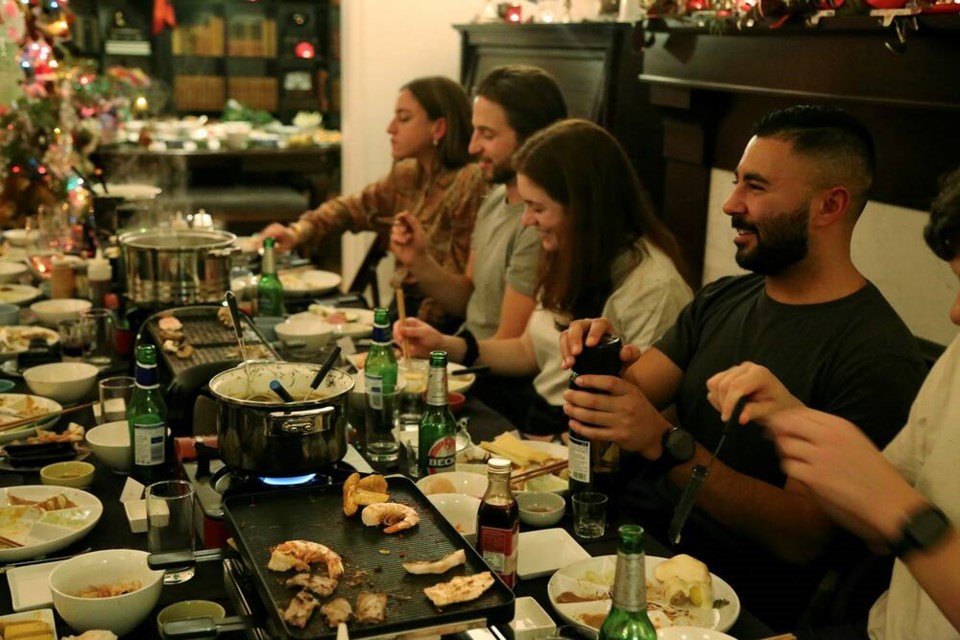Homegrown spring and summer greens made an appearance on our New Year’s Day dinner table this year, which was delightful and also strange.
Three varieties of pea shoots, baby fennel, baby rainbow chard, baby Siberian kale, cutting celery, sorrel and dock bunched up together on a tray next to the usual selection of cut root and storage vegetables with shiitake mushrooms that define the vegetable section of our annual cook-your-own hot-pot/raclette event.
The tradition started years ago with a single inexpensive tabletop hot-pot burner around which our young family of five would delight in cooking our own thinly sliced chicken and beef, and assorted favourite vegetables, then dipping them in home-made sauces. After a few years we added a basic raclette grill upon which we seared meat, seafood and vegetables, but also melted cheese under the mini salamander-type element below.
As the years went on, we extended the table and added one and then two more hot pots and grills, so that all three of our children and their closest friends could embrace the event and make it their own. Known now simply and affectionately as “the hot-pot dinner,” this slow-burn communal table is held on the first day of each new year, and has become our favourite family meal.
Our grown children and their friends arrive early and stay late. Modest pourings of warm sake accompany home-made salad rolls and sunomono salad. Guests graze leisurely from a local organic raw-food buffet: a rainbow of bite-sized vegetables and mushrooms, small bowls of pre-cut bison, chicken and pork, plus prawns, scallops and tuna, and our favourite melty cheeses. And last but not least, a large bowl of tiny, steamed potatoes.
Home-made sauces – spicy peanut with lime and ginger, and chili Thai are non-negotiables, but this year we added a rather hot orange teriyaki, and a green curry coconut concoction also – all served in squirt bottles for ease and fun.
What began as a simple culinary adventure has grown into a two-day affair, the prepping for which is calming and contemplative after the hustle of the holidays. Chopping and saucing, re-locating living room furniture and setting up the great long table has become a ritual. Nothing goes to waste. Left-overs become “hot-pot paella” – frittata or soup enriched by reduced hot-pot broth.
The favourite ingredients this year, other than the green curry sauce for which I did not write down the recipe, sadly, were the just-picked baby garden greens. I have no empirical explanation for why these food plants are growing like weeds currently, but I suspect it is the living soil and the deep mulch. Just weeks ago, our youngest daughter pulled up the last of the frost-sweetened heirloom carrots and beets for storage, and the soil she said was “warm and crumbly with worms.”
Typically and expectedly, the second hard frost wilts late-summer planted peas, and the cut fennel lay dormant until spring. Likewise, cut perennial chard, kale and celery settle in unless cold-framed or fleeced.
This year, we leaf mulched over vermi-compost early and extensively. Also, we sunk six lidded, six-gallon galvanized pails drilled throughout with quarter-inch holes, into a half-wide raised bed to use as ancillary in-bed vermicomposts. The late-sown spring peas that grow alongside them on tiny iron obelisks sunk into deeply-mulched worm casting-fortified soil, are unseasonably happy and climate-confused.
I too am happy, but not at all confused. Living soil is life. Happy new year!
Laura Marie Neubert is a West Vancouver-based urban permaculture designer. Follow her on Instagram @upfrontandbeautiful, learn more about permaculture by visiting her Upfront & Beautiful website or email your questions to her here.
For a taste of permaculture, watch the video below:




